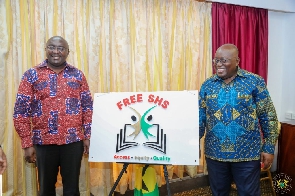The Akufo-Addo government has so far invested over 12 billion Ghana Cedis (120 trillion old cedis) in the free secondary education of Ghanaian children since the policy came into effect in 2017, Citi News has reported.
According to data posted by Citi, sourced from Africa Education Watch, the government has so far spent a remarkable GH 12,881,285,548 (twelve billion, eight hundred and eighty-one million, two hundred and eighty-five thousand, five hundred and forty-eight Ghana Cedis) so far, in five years, which is equivalent to 120 trillion old Cedis.
The data gives the breakdown of the Akufo-Addo government's annual budgetary allocation for Free SHS from the time it started in 2027 up to 2023, and it reveals a staunch commitment to the programme by the government, as the 2023 budget of GH 2,957,502,092 was a whopping 600% increment on the inaugural budget of 400,000,000 in 2017, when the NPP Government assumed office.
According to the data, the Government increased the budgetary allocation to
GH 1,137,861,816 in the second year of Free SHS in 2018, and further increased it to GH 1,682,641,924 and GH 2,429,257,748 in 2019 and 2020 respectively.
Following the devastation of COVID-19 in the year 2020, which affected government revenue, the Free SHS budget, for the first time in 4 years, was cut down to GH 1,974,021,968 in 2021 but the government significantly increased it again in 2023 to GH 2,300,000,000 Cedis.
Notwithstanding an IMF programme in 2023, the government's budget for the Free SHS in 2023 was not affected. The budget saw a significant increase from the GH2,300,000,000 Cedis in 2022 to GH 2,957,502,092.
The above figures, undoubtedly demonstrates unwavering commitment on the part of the Government of President Akufo-Addo towards delivering its flagship Free SHS programme, which dominated discussions prior to the President's election and assumption of office in 2017 from former President Mahama.
IMPACT
The Free SHS policy, no doubt, has had a significant impact on secondary education in Ghana with enrollment increasing from 800,000 to 1.4m students since 2017; a percentage increase of about 75%.
Due to the high demand and free access, the government has had to also invest in expanding infrastructure, such as classroom and dormitory blocks to be able to accommodate more students in both day and boarding schools.
According to government data, nearly 2000 classrooms and dormitory blocks have been built in schools across the country to meet the increasing demands of Free SHS, since the policy was introduced.
Apart from the significant increase in enrollment, the Free SHS policy has also succeeded in achieving virtual gender parity in secondary school enrollment in Ghana.
Hitherto, there was a great imbalance between male and female in secondary school enrollment, as many females were left behind, largely due to many families' inability to concurrently fund the secondary education of both male and female members.
Often, the male child was favoured, leaving the female to drop out of school at the JHS level.

General News of Tuesday, 19 December 2023
Source: www.ghanaweb.com

















